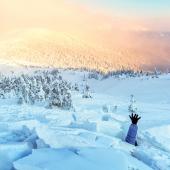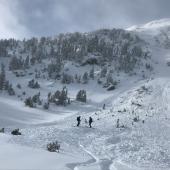Avalanche Eyeballs
I get excited at the thought of fresh powder and start to salivate every time I hear, “a winter storm warning is in effect.” Obviously others share my obsession since each storm is followed by a shortage of workers in Bozeman, as folks call in sick and play hooky. Let’s face it, we all live here to take advantage of these deep, powder-choking opportunities, especially since these memories fuel us through the dry spells. However, along with the pleasure that backcountry powder brings, we need to keep our senses honed for avalanche danger. The old adage “More snow equals more avalanches” poses the crux of the avalanche danger puzzle since we also know that “More snow equals more fun.”
Lucky for us, Mother Nature provides useful clues about the stability of the snow. You just need to open your “avalanche eyeballs” in order to see them. Have you ever noticed how hunters see things in the woods that others miss? They’ve trained themselves to look for specific clues about where the animals are. Well, being aware of snow and avalanche conditions are no different; it just takes a little practice.
Recent avalanche activity is Mother Nature’s lights and siren that the snowpack is unstable. If you’re trying to answer the question, “Can the snow slide?” a recent avalanche is an ear splitting “Yes!” It gets no clearer than this, yet folks who haven’t developed their avalanche eyeballs carelessly ski, board, and ride slopes adjacent to avalanche activity. You can start searching for this obvious sign of instability as soon as you get in your vehicle and drive to the trailhead. Recent slides emphatically point to unstable conditions since avalanches result from the snowpack having more stress than strength. During and immediately after big storms the snowpack is under its greatest stress and sometimes this balance is so delicate that the weight of a person can tip the scales and trigger an avalanche.
Have you ever heard or felt the snow “whumph” underneath you, or see cracks shooting out ahead? It’s a heart-stopping experience and another red flag that the snow is unstable. What just happened is that your weight collapsed a weak layer buried in the snowpack, and if you weren’t caught in an avalanche it’s likely because you were on low-angled terrain. Consider yourself lucky. In fact, any time you see these warning signs, you should limit your travel to slopes well under 30 degrees.
Start developing your avalanche eyeballs the next time you head out. Over time, by forcing yourself to look closely for patterns of instability, you’ll begin to notice things others in your party missed. Additionally, the daily avalanche advisories will highlight our concerns about the snowpack and help you hone your observation skills. You can hear the advisory by 7:30 every morning by calling 587-6981, or you can read it on the Gallatin National Forest Avalanche Center website (www.mtavalanche.com). As always, travel one at a time in avalanche terrain, carry rescue gear and know how to use it, and most importantly, take an avalanche class. Knowledge is a powerful tool.
Doug Chabot is the director of the Gallatin National Forest Avalanche Center.











